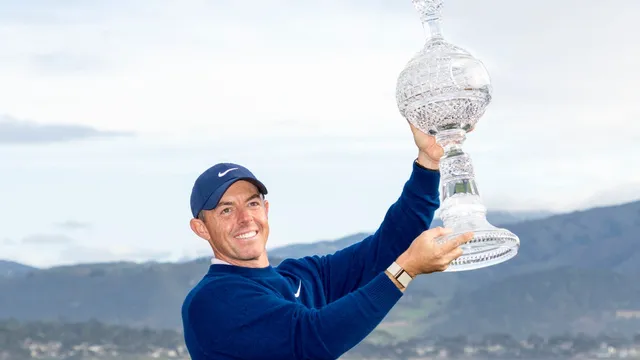
Rory McIlroy secures 27th PGA Tour title at Pebble Beach
2025-02-03 07:21- Rory McIlroy achieved a remarkable two-shot victory at Pebble Beach.
- The final round featured impressive plays, including an eagle on the crucial 14th hole.
- This win marks McIlroy's 27th title on the PGA Tour, enhancing his stature in professional golf.
Express your sentiment!
Insights
In the United States, Rory McIlroy showcased a stunning performance at the AT&T Pebble Beach Pro-Am, clinching his 27th PGA Tour title. The Northern Irish golfer entered the final round trailing by one shot but surged ahead with two key birdies after the turn. An impressive eagle on the par-five 14th hole cemented his lead, allowing him to finish with a six-under 66, bringing his final score to 21 under par. Shane Lowry finished second after recording five birdies in the last eight holes, while Justin Rose ended third with a spectacular eagle on the final hole, showcasing the competitiveness of the event. The tournament provided McIlroy with significant momentum as he aims to build on this success moving forward, emphasizing the prestige of winning at Pebble Beach, a renowned golfing venue. This victory marks a notable milestone in McIlroy's career as he sets his sights on future tournaments and continues to establish his legacy on the PGA Tour.
Contexts
The history of hole-in-ones in golf is rich and fascinating, capturing the essence of skill, chance, and the unique thrill associated with this remarkable achievement. A hole-in-one occurs when a golfer successfully hits the ball from the tee into the cup in a single stroke. This feat is particularly celebrated in golf due to its rarity, with professionals and amateurs alike striving for this coveted accomplishment. The origins of the hole-in-one can be traced back to the early days of golf, with some historical accounts suggesting that holes-in-one were recognized as early as the 17th century in Scotland, where the sport first gained prominence. As golf evolved into a popular pastime, especially in the late 19th and early 20th centuries, so too did the allure of achieving a hole-in-one. Several tournaments and championship events began celebrating these moments, further embedding the hole-in-one in golf culture. One of the most notable milestones in the history of hole-in-ones was the formation of official records and the efforts by various organizations to track these elusive achievements. The use of standardized golf courses and the establishment of rules around the sport helped to solidify the hole-in-one as a benchmark for measuring a golfer's prowess. In 1938, the first recorded hole-in-one at the professional level was achieved by the legendary golfer Paul Runyan during a tournament. This marked a significant moment that led to the formal recognition of holes-in-one in professional competitions, igniting interest among spectators and fellow players. Over the years, advancements in golf technology, such as improved club and ball designs, have also played a role in increasing the number of recorded holes-in-one. As a result of its esteemed status, many golf courses and organizations have developed special hole-in-one contests and prizes to commemorate this remarkable achievement. Golfers who manage to score a hole-in-one often receive accolades, including plaques, trophies, or even cash prizes. Some notable examples include special insurance policies offered by courses to reward players for achieving a hole-in-one during tournaments. This not only adds to the excitement of the game but also fosters a supportive community where golfers share their experiences and celebrate each other's successes. Among professional golfers, some legendary figures, including Jack Nicklaus and Tiger Woods, have celebrated multiple holes-in-one throughout their careers, with Woods famously scoring his first at the tender age of 6. While the achievement of a hole-in-one remains rare—estimates suggest the odds of an amateur making one are around 12,500 to 1, while professionals fare slightly better—its grandeur continues to captivate audiences. The thrill of making a hole-in-one is a shared experience among golfers, contributing to the sport's rich history and culture. As we look toward the future of golf, the allure of the hole-in-one will undoubtedly persist, cementing its place as one of the most exciting moments in the sport's storied lineage.